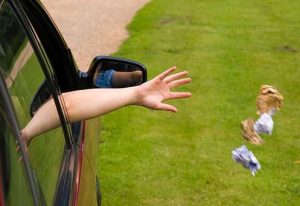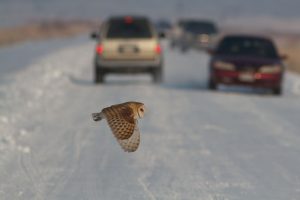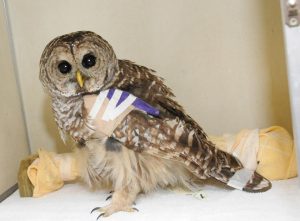By Jenna Krebs, Irvine’s Animal Care Coordinator
With the weather’s constant changes these past few weeks, many animals are out and on the move.
Just as the animals become more active, so do people, and this means human-animal encounters become more prevalent. This morning an Irvine Board member brought me quite a surprise…inside of a cardboard box with some holes poked in the side was a gorgeous, but very lethargic barred owl. The owl had gotten hung up in a neighbor’s car rack while they were driving home last night. A few good samaritans were able to safely get the owl unstuck and into a dark cardboard box with a towel. Since it was late at night, no rehabilitation facilities were open, so the owl would have to hang on until morning. Morning came and she was still alive, the Board member brought her to Irvine to get some help. When I peeked in the box I could tell that she was definitely injured…a possible broken wing, hurt foot and maybe other internal injuries. After getting as much information possible, I hopped in my car and took the owl to a wildlife rehabilitator. We will find out the status of the barred owl in a few days.
Many of you might be wondering “how did an owl get stuck on a car?!” The answer is relatively simple, and unfortunately, all too common. Barred owls (and all other birds of prey) don’t look both ways before they cross the road! Yes, I know this sounds funny, but that’s essentially what happens! Often times as you are driving down the road, you are multitasking by eating a snack. Whether it be an apple, banana, french fries, etc. What do you do with the leftovers? Most people (and I have been guilty of this) just toss the apple core out the window. It’s biodegradable, so it will rot and return to the Earth! I’m helping to feed animals! And so many other reasons that your action is deemed ‘okay.’ But what really happens to that apple core? Sure, it would decompose, given time, but more often than not, before that happens a little mouse finds that tasty treat along the side of the road. As the mouse is nibbling away, a bird of prey sees that mouse as a tasty snack! With their sights set on grabbing up that furry meal that’s out in the open, they do not worry about anything else. As they dive across the road, talons at the ready, a car smashes into them. Bam! Lights out. Some are lucky and survive the ordeal while others are killed instantly. The “lucky” ones who survive the initial threat, now have other things to worry about. Maybe the car broke a wing, maybe the impact caused a retina to detach, or maybe they just got a little stunned. Any of those options and countless others can cause the bird to become easy prey for a larger carnivore.
So how do we prevent birds of prey from getting close to roadways? The simplest solution is to “trash your trash.” Take anything that you no longer want home with you and dispose of it in the appropriate manner. That could be in a trashcan, a recycling bin, or even a compost pile. Just by changing your mindset from “out of sight, out of mind” to “what consequences does my action have in the future?” can help save so many animals; and is good life advice overall! Everything we humans do has an impact on either another human, an animal, or both. If we set our minds to it, we could change negative impacts into positive ones.
But what if an owl still dive-bombs my car!? What do I do? If you are aware that you have hit an owl (or any animal), the first step is to slow down, pull over and remain calm. Make sure that you are safe first. Check for traffic, make sure everyone in the car is alright. Then worry about the animal. When you approach the injured animal, keep in mind that it is scared and aggression comes from fear. The animal may bite, kick or try to protect itself in whatever way it deems fit. If you are able to safely collect the animal into a cardboard box, take it to your nearest wildlife rehabilitator. If you do not feel comfortable catching the animal, call animal control or a rehab facility and they will either come out to the location, or help you through collecting the animal. It is important that the animal stays in a dark and quiet area, and preferably kept warm. A cardboard box with a blanket is the ideal situation. When you arrive at the rehabber’s location, be ready to answer some basic questions about how, when and where you found the animal. Also, remember that not every animal is going to survive. The rehabber will try their best, but sometimes, there is nothing that can be done. Another thing to think about when you drop the injured wildlife off is that most animal rehab facilities run solely on volunteer hours and donations. If you have a couple dollars to spare, please think about donating. Animals are expensive to feed and care for, let alone to heal an injury. Most rehab locations will then give the animal an identification number with which you can call back in a few days to see how they are doing.
Human-animal encounters through car strikes are just one of the ways that wildlife can become injured. If you would like more information on how you can prevent negative human-animal encounters, please come visit us here at Irvine and we’d be happy to chat with you. If you have a sick or injured wild animal and need rehabilitation contact info, please call the center at 443-738-9200.






